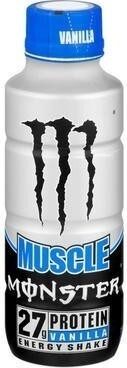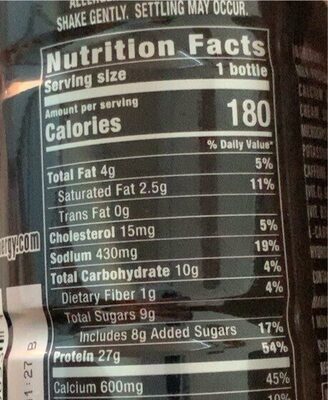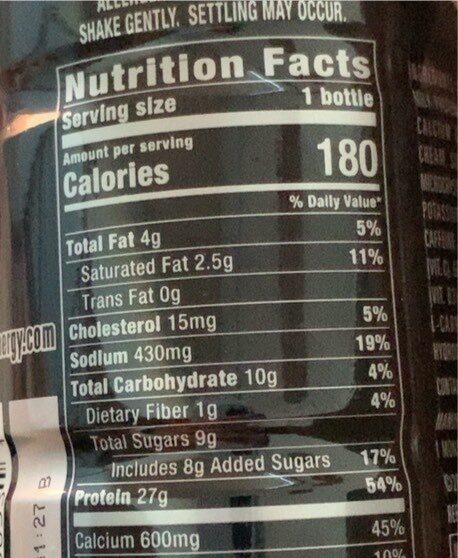Help us make food transparency the norm!
As a non-profit organization, we depend on your donations to continue informing consumers around the world about what they eat.
The food revolution starts with you!
Muscle vanilla energy shake
Muscle vanilla energy shake
This product page is not complete. You can help to complete it by editing it and adding more data from the photos we have, or by taking more photos using the app for Android or iPhone/iPad. Thank you!
×
Barcode: 0070847030331 (EAN / EAN-13) 070847030331 (UPC / UPC-A)
Brand owner: MUSCLE MONSTER
Categories: Beverages, Energy drinks
Countries where sold: France, United States
Matching with your preferences
Health
Ingredients
-
27 ingredients
Water, milk protein concentrate, calcium caseinate (milk), cream, sugar, glucose, taurine, microcrystalline cellulose, sodium citrate, potassium citrate, salt, cellulose gum, caffeine, natural flavors, ascorbic acid (vit. c), gellan gum, sucralose, niacinamide (vit. b3), acesulfame potassium, inositol, l-carnitine l-tartrate, pyridoxine hydrochloride (vit. b6), riboflavin (vit. b2).Allergens: Milk
Food processing
-
Ultra processed foods
Elements that indicate the product is in the 4 - Ultra processed food and drink products group:
- Additive: E418 - Gellan gum
- Additive: E460 - Cellulose
- Additive: E466 - Sodium carboxy methyl cellulose
- Additive: E950 - Acesulfame k
- Additive: E955 - Sucralose
- Ingredient: Flavouring
- Ingredient: Glucose
- Ingredient: Milk proteins
Food products are classified into 4 groups according to their degree of processing:
- Unprocessed or minimally processed foods
- Processed culinary ingredients
- Processed foods
- Ultra processed foods
The determination of the group is based on the category of the product and on the ingredients it contains.
Additives
-
E331 - Sodium citrates
Sodium citrate: Sodium citrate may refer to any of the sodium salts of citrate -though most commonly the third-: Monosodium citrate Disodium citrate Trisodium citrateThe three forms of the salt are collectively known by the E number E331. Sodium citrates are used as acidity regulators in food and drinks, and also as emulsifiers for oils. They enable cheeses to melt without becoming greasy.Source: Wikipedia
-
E418 - Gellan gum
Gellan gum: Gellan gum is a water-soluble anionic polysaccharide produced by the bacterium Sphingomonas elodea -formerly Pseudomonas elodea based on the taxonomic classification at the time of its discovery-. Its taxonomic classification has been subsequently changed to Sphingomonas elodea based on current classification system. The gellan-producing bacterium was discovered and isolated by the former Kelco Division of Merck & Company, Inc. in 1978 from the lily plant tissue from a natural pond in Pennsylvania, USA. It was initially identified as a substitute gelling agent at significantly lower use level to replace agar in solid culture media for the growth of various microorganisms Its initial commercial product with the trademark as "GELRITE" gellan gum, was subsequently identified as a suitable agar substitute as gelling agent in various clinical bacteriological media.Source: Wikipedia
-
E460 - Cellulose
Cellulose: Cellulose is an organic compound with the formula -C6H10O5-n, a polysaccharide consisting of a linear chain of several hundred to many thousands of β-1→4- linked D-glucose units. Cellulose is an important structural component of the primary cell wall of green plants, many forms of algae and the oomycetes. Some species of bacteria secrete it to form biofilms. Cellulose is the most abundant organic polymer on Earth. The cellulose content of cotton fiber is 90%, that of wood is 40–50%, and that of dried hemp is approximately 57%.Cellulose is mainly used to produce paperboard and paper. Smaller quantities are converted into a wide variety of derivative products such as cellophane and rayon. Conversion of cellulose from energy crops into biofuels such as cellulosic ethanol is under development as a renewable fuel source. Cellulose for industrial use is mainly obtained from wood pulp and cotton.Some animals, particularly ruminants and termites, can digest cellulose with the help of symbiotic micro-organisms that live in their guts, such as Trichonympha. In human nutrition, cellulose is a non-digestible constituent of insoluble dietary fiber, acting as a hydrophilic bulking agent for feces and potentially aiding in defecation.Source: Wikipedia
-
E460i - Microcrystalline cellulose
Cellulose: Cellulose is an organic compound with the formula -C6H10O5-n, a polysaccharide consisting of a linear chain of several hundred to many thousands of β-1→4- linked D-glucose units. Cellulose is an important structural component of the primary cell wall of green plants, many forms of algae and the oomycetes. Some species of bacteria secrete it to form biofilms. Cellulose is the most abundant organic polymer on Earth. The cellulose content of cotton fiber is 90%, that of wood is 40–50%, and that of dried hemp is approximately 57%.Cellulose is mainly used to produce paperboard and paper. Smaller quantities are converted into a wide variety of derivative products such as cellophane and rayon. Conversion of cellulose from energy crops into biofuels such as cellulosic ethanol is under development as a renewable fuel source. Cellulose for industrial use is mainly obtained from wood pulp and cotton.Some animals, particularly ruminants and termites, can digest cellulose with the help of symbiotic micro-organisms that live in their guts, such as Trichonympha. In human nutrition, cellulose is a non-digestible constituent of insoluble dietary fiber, acting as a hydrophilic bulking agent for feces and potentially aiding in defecation.Source: Wikipedia
-
E466 - Sodium carboxy methyl cellulose
Carboxymethyl cellulose: Carboxymethyl cellulose -CMC- or cellulose gum or tylose powder is a cellulose derivative with carboxymethyl groups --CH2-COOH- bound to some of the hydroxyl groups of the glucopyranose monomers that make up the cellulose backbone. It is often used as its sodium salt, sodium carboxymethyl cellulose.Source: Wikipedia
-
E950 - Acesulfame k
Acesulfame potassium: Acesulfame potassium - AY-see-SUL-faym-, also known as acesulfame K -K is the symbol for potassium- or Ace K, is a calorie-free sugar substitute -artificial sweetener- often marketed under the trade names Sunett and Sweet One. In the European Union, it is known under the E number -additive code- E950. It was discovered accidentally in 1967 by German chemist Karl Clauss at Hoechst AG -now Nutrinova-. In chemical structure, acesulfame potassium is the potassium salt of 6-methyl-1‚2,3-oxathiazine-4-3H--one 2‚2-dioxide. It is a white crystalline powder with molecular formula C4H4KNO4S and a molecular weight of 201.24 g/mol.Source: Wikipedia
-
E955 - Sucralose
Sucralose: Sucralose is an artificial sweetener and sugar substitute. The majority of ingested sucralose is not broken down by the body, so it is noncaloric. In the European Union, it is also known under the E number E955. It is produced by chlorination of sucrose. Sucralose is about 320 to 1‚000 times sweeter than sucrose, three times as sweet as both aspartame and acesulfame potassium, and twice as sweet as sodium saccharin. Evidence of benefit is lacking for long-term weight loss with some data supporting weight gain and heart disease risks.It is stable under heat and over a broad range of pH conditions. Therefore, it can be used in baking or in products that require a long shelf life. The commercial success of sucralose-based products stems from its favorable comparison to other low-calorie sweeteners in terms of taste, stability, and safety. Common brand names of sucralose-based sweeteners are Splenda, Zerocal, Sukrana, SucraPlus, Candys, Cukren, and Nevella. Canderel Yellow also contains sucralose, but the original Canderel and Green Canderel do not.Source: Wikipedia
Ingredients analysis
-
Palm oil free
No ingredients containing palm oil detected
-
Non-vegan
Non-vegan ingredients: Milk protein concentrate, Calcium caseinate, Cream, L-carnitine-L-tartrate
-
Vegetarian status unknown
Unrecognized ingredients: Sodium citrate, Vitamin C
-
Details of the analysis of the ingredients
: Water, milk protein concentrate, calcium caseinate, cream, sugar, glucose, taurine, microcrystalline cellulose, sodium citrate, potassium citrate, salt, cellulose gum, caffeine, natural flavors, ascorbic acid (vitamin c), gellan gum, sucralose, niacinamide (vitamin b3), acesulfame potassium, inositol, l-carnitine l-tartrate, pyridoxine hydrochloride (vitamin b6), riboflavin (vitamin b2)- Water -> en:water - vegan: yes - vegetarian: yes - ciqual_food_code: 18066 - percent_min: 4.34782608695652 - percent_max: 100
- milk protein concentrate -> en:milk-protein-concentrate - vegan: no - vegetarian: yes - percent_min: 0 - percent_max: 50
- calcium caseinate -> en:calcium-caseinate - vegan: no - vegetarian: yes - percent_min: 0 - percent_max: 33.3333333333333
- cream -> en:cream - vegan: no - vegetarian: yes - ciqual_food_code: 19402 - percent_min: 0 - percent_max: 25
- sugar -> en:sugar - vegan: yes - vegetarian: yes - ciqual_proxy_food_code: 31016 - percent_min: 0 - percent_max: 2.027027027027
- glucose -> en:glucose - vegan: yes - vegetarian: yes - ciqual_proxy_food_code: 31016 - percent_min: 0 - percent_max: 2.027027027027
- taurine -> en:taurine - vegan: maybe - vegetarian: maybe - percent_min: 0 - percent_max: 2.027027027027
- microcrystalline cellulose -> en:e460i - vegan: yes - vegetarian: yes - percent_min: 0 - percent_max: 2.027027027027
- sodium citrate -> en:sodium-citrate - percent_min: 0 - percent_max: 2.027027027027
- potassium citrate -> en:e332ii - vegan: yes - vegetarian: yes - percent_min: 0 - percent_max: 2.027027027027
- salt -> en:salt - vegan: yes - vegetarian: yes - ciqual_food_code: 11058 - percent_min: 0 - percent_max: 0.24211711711712
- cellulose gum -> en:e466 - vegan: yes - vegetarian: yes - percent_min: 0 - percent_max: 0.24211711711712
- caffeine -> en:caffeine - vegan: yes - vegetarian: yes - percent_min: 0 - percent_max: 0.24211711711712
- natural flavors -> en:natural-flavouring - vegan: maybe - vegetarian: maybe - percent_min: 0 - percent_max: 0.24211711711712
- ascorbic acid -> en:e300 - vegan: yes - vegetarian: yes - percent_min: 0 - percent_max: 0.24211711711712
- vitamin c -> en:vitamin-c - percent_min: 0 - percent_max: 0.24211711711712
- gellan gum -> en:e418 - vegan: yes - vegetarian: yes - percent_min: 0 - percent_max: 0.24211711711712
- sucralose -> en:e955 - vegan: yes - vegetarian: yes - percent_min: 0 - percent_max: 0.24211711711712
- niacinamide -> en:e375 - vegan: maybe - vegetarian: maybe - percent_min: 0 - percent_max: 0.24211711711712
- vitamin b3 -> en:e375 - vegan: maybe - vegetarian: maybe - percent_min: 0 - percent_max: 0.24211711711712
- acesulfame potassium -> en:e950 - vegan: yes - vegetarian: yes - percent_min: 0 - percent_max: 0.24211711711712
- inositol -> en:inositol - vegan: yes - vegetarian: yes - percent_min: 0 - percent_max: 0.24211711711712
- l-carnitine l-tartrate -> en:l-carnitine-l-tartrate - vegan: no - vegetarian: maybe - percent_min: 0 - percent_max: 0.24211711711712
- pyridoxine hydrochloride -> en:pyridoxine-hydrochloride - vegan: yes - vegetarian: yes - percent_min: 0 - percent_max: 0.24211711711712
- vitamin b6 -> en:vitamin-b6 - vegan: yes - vegetarian: yes - percent_min: 0 - percent_max: 0.24211711711712
- riboflavin -> en:e101 - vegan: maybe - vegetarian: yes - percent_min: 0 - percent_max: 0.24211711711712
- vitamin b2 -> en:e101 - vegan: maybe - vegetarian: yes - percent_min: 0 - percent_max: 0.24211711711712
Nutrition
-
Poor nutritional quality
⚠ ️Warning: the amount of fruits, vegetables and nuts is not specified on the label, it was estimated from the list of ingredients: 0This product is considered a beverage for the calculation of the Nutri-Score.
Positive points: 3
- Proteins: 3 / 5 (value: 6.0810810810811, rounded value: 6.08)
- Fiber: 0 / 5 (value: 0.22522522522523, rounded value: 0.23)
- Fruits, vegetables, nuts, and colza/walnut/olive oils: 0 / 10 (value: 0, rounded value: 0)
Negative points: 9
- Energy: 6 / 10 (value: 170, rounded value: 170)
- Sugars: 2 / 10 (value: 2.027027027027, rounded value: 2)
- Saturated fat: 0 / 10 (value: 0.56306306306306, rounded value: 0.6)
- Sodium: 1 / 10 (value: 96.846846846848, rounded value: 96.8)
The points for proteins are counted because the negative points are less than 11.
Nutritional score: (9 - 3)
Nutri-Score:
-
Nutrient levels
-
Fat in low quantity (0.901%)
What you need to know- A high consumption of fat, especially saturated fats, can raise cholesterol, which increases the risk of heart diseases.
Recommendation: Limit the consumption of fat and saturated fat- Choose products with lower fat and saturated fat content.
-
Saturated fat in low quantity (0.563%)
What you need to know- A high consumption of fat, especially saturated fats, can raise cholesterol, which increases the risk of heart diseases.
Recommendation: Limit the consumption of fat and saturated fat- Choose products with lower fat and saturated fat content.
-
Sugars in low quantity (2.03%)
What you need to know- A high consumption of sugar can cause weight gain and tooth decay. It also augments the risk of type 2 diabetes and cardio-vascular diseases.
Recommendation: Limit the consumption of sugar and sugary drinks- Sugary drinks (such as sodas, fruit beverages, and fruit juices and nectars) should be limited as much as possible (no more than 1 glass a day).
- Choose products with lower sugar content and reduce the consumption of products with added sugars.
-
Salt in moderate quantity (0.242%)
What you need to know- A high consumption of salt (or sodium) can cause raised blood pressure, which can increase the risk of heart disease and stroke.
- Many people who have high blood pressure do not know it, as there are often no symptoms.
- Most people consume too much salt (on average 9 to 12 grams per day), around twice the recommended maximum level of intake.
Recommendation: Limit the consumption of salt and salted food- Reduce the quantity of salt used when cooking, and don't salt again at the table.
- Limit the consumption of salty snacks and choose products with lower salt content.
-
-
Nutrition facts
Nutrition facts As sold
for 100 g / 100 mlAs sold
per serving (1 BOTTLE (450 ml))Compared to: Energy drinks Energy 170 kj
(40 kcal)765 kj
(182 kcal)+34% Fat 0.901 g 4.05 g +2,000% Saturated fat 0.563 g 2.53 g +5,599% Trans fat 0 g 0 g Cholesterol 3 mg 13.5 mg +249% Carbohydrates 2.252 g 10.1 g -67% Sugars 2.027 g 9.12 g -67% Fiber 0.225 g 1.01 g +419% Proteins 6.081 g 27.4 g +5,531% Salt 0.242 g 1.09 g +111% Vitamin C (ascorbic acid) 12 mg 54 mg -52% Vitamin B2 (Riboflavin) 0.718 mg 3.23 mg -24% Vitamin B3/PP (Niacin) 8.444 mg 38 mg +24% Vitamin B6 (Pyridoxin) 0.844 mg 3.8 mg -11% Potassium 100 mg 450 mg +36% Calcium 133 mg 599 mg +151% Fruits‚ vegetables‚ nuts and rapeseed‚ walnut and olive oils (estimate from ingredients list analysis) 0 % 0 %
Environment
-
Eco-Score not yet applicable
Not yet applicable for the category: Energy drinks
The Eco-Score is not yet applicable for this category, but we are working on adding support for it.
Packaging
-
Missing packaging information for this product
⚠ ️ The information about the packaging of this product is not filled in.Take a photo of the recycling information Take a photo of the recycling information
Transportation
-
Origins of ingredients
Missing origins of ingredients information
⚠ ️ The origins of the ingredients of this product are not indicated.
If they are indicated on the packaging, you can modify the product sheet and add them.
If you are the manufacturer of this product, you can send us the information with our free platform for producers.Add the origins of ingredients for this product Add the origins of ingredients for this product
Report a problem
-
Incomplete or incorrect information?
Category, labels, ingredients, allergens, nutritional information, photos etc.
If the information does not match the information on the packaging, please complete or correct it. Open Food Facts is a collaborative database, and every contribution is useful for all.
Data sources
Product added on by kiliweb
Last edit of product page on by kiliweb.
Product page also edited by autorotate-bot, openfoodfacts-contributors, org-database-usda, sebleouf, yuka.UzZZZk41UWUvdFl1b3MwWi94RGYxdElwNGNXVmZVeTJDdXNxSVE9PQ, yuka.sY2b0xO6T85zoF3NwEKvllxmDuvkpQ2ebzHjxFeX7NOiP73pO-hK_43QMas.








